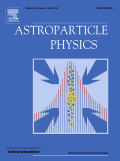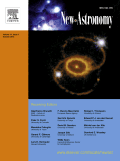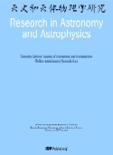
Astrophysical Bulletin
metrics 2024
Connecting Scholars to the Wonders of the Universe
Introduction
Welcome to the Astrophysical Bulletin, an esteemed journal published by MAIK NAUKA/INTERPERIODICA/SPRINGER that has been contributing to the fields of Astronomy and Astrophysics since its inception in 2009. With a prominent Q3 rating in both Astronomy and Astrophysics and Instrumentation, this journal is designed to foster an understanding of astronomical phenomena through comprehensive research articles and groundbreaking discoveries. While currently not offering open access, it remains a vital resource for researchers and professionals looking to stay informed on the latest advances in the field, featuring a compelling selection of peer-reviewed studies that underscore its relevance and impact. The Astrophysical Bulletin ranks impressively in Scopus, making it a trusted platform for disseminating vital knowledge and new insights into our universe.
Metrics 2024
 0.35
0.35 1.30
1.30 1.00
1.00 23
23Metrics History
Rank 2024
Scopus
IF (Web Of Science)
JCI (Web Of Science)
Quartile History
Similar Journals

REVISTA MEXICANA DE ASTRONOMIA Y ASTROFISICA
Illuminating the Universe, One Study at a TimeRevista Mexicana de Astronomía y Astrofísica, published by the Universidad Nacional Autónoma de México (INSTITUTO DE ASTRONOMÍA), is a prominent academic journal dedicated to advancing the knowledge and understanding of astronomy and astrophysics. As a Q3-ranked journal in both Astronomy and Astrophysics, and Space and Planetary Science in 2023, it serves as an invaluable platform for researchers and professionals within these fields. With an ISSN of 0185-1101, this journal seeks to foster innovative research and dialogue among scholars, presenting groundbreaking studies spanning from theoretical astrophysics to observational astronomy. Although it does not operate under an open-access model, the journal remains vital for its contributions to scientific literature from Mexico, with articles converging over several decades from 1996 to 2024. By offering insights into the latest findings and methodologies, Revista Mexicana de Astronomía y Astrofísica not only enhances the academic landscape but also inspires future generations of scientists and students passionate about unraveling the mysteries of the universe.

Advances in Astronomy and Space Physics
Exploring the Cosmos, One Discovery at a Time.Advances in Astronomy and Space Physics is an esteemed journal dedicated to the exploration and dissemination of research in the expansive fields of astronomy and space science. Published by Taras Shevchenko National University of Kyiv, this journal provides a platform for researchers, professionals, and students to share groundbreaking studies and innovations. With an ISSN of 2227-1481, it covers a wide range of subjects including astrophysics, planetary sciences, and space exploration technologies, thereby fostering interdisciplinary collaboration. Although not an Open Access journal, it maintains a commitment to high-quality, peer-reviewed content that contributes significantly to the advancement of scientific knowledge. The journal's mission is to promote sustainable practices in space research while also exploring the implications of discoveries on Earth and beyond. By maintaining rigorous publication standards, Advances in Astronomy and Space Physics aims to serve as a critical resource for those involved in the ever-evolving study of our universe.

ASTROPARTICLE PHYSICS
Charting New Territories in Astroparticle PhysicsASTROPARTICLE PHYSICS is a premier international journal dedicated to advancing the understanding of the intersection between particle physics, astronomy, and astrophysics. Published by Elsevier, this journal has established itself as a leading source of research insights since its inception in 1992, with a remarkable impact factor positioning it within the Q1 category for Astronomy and Astrophysics for 2023. With a Scopus ranking of 18 out of 90 in its field, representing the top 80th percentile, ASTROPARTICLE PHYSICS serves as an essential platform for disseminating groundbreaking research that influences astrophysical studies and cosmological theories. Researchers and academics have access to a robust collection of peer-reviewed articles that explore various dimensions of astroparticle phenomena, collaborative cosmic investigations, and theoretical advancements. Although not an open-access journal, it provides extensive research coverage accessible to a global audience from its headquarters in Amsterdam, Netherlands, offering a vital resource for those seeking to push the boundaries of knowledge in the realms of astrophysics and particle physics.

ASTROPHYSICS
Shaping the Future: Essential Research in Astronomy and AstrophysicsASTROPHYSICS, published by Springer/Plenum Publishers, stands as a crucial platform for the dissemination of groundbreaking research in the field of Astronomy and Astrophysics. Established in 1965 and continuing its legacy until 2024, the journal highlights significant advancements, theoretical frameworks, and observational data that collectively push the boundaries of our understanding of the universe. Although currently categorized in the Q4 quartile for Astronomy and Astrophysics and holding a Scopus rank within the 17th percentile, ASTROPHYSICS remains dedicated to offering rigorous peer-reviewed content that is essential for researchers, professionals, and students alike. While it does not provide open access, the journal's accessibility through institutional subscriptions ensures a wide reach among the academic community, allowing it to address the rising curiosity surrounding cosmic phenomena and contribute meaningfully to ongoing scholarly discourse. For those seeking to engage with the latest findings and methodologies in astrophysics, ASTROPHYSICS continues to serve as an indispensable resource.

Journal of Cosmology and Astroparticle Physics
Charting New Frontiers in Astroparticle ResearchThe Journal of Cosmology and Astroparticle Physics (ISSN: 1475-7516) is a premier publication in the field of astronomy and astrophysics, dedicated to advancing our understanding of the cosmos through innovative research. Published by IOP Publishing Ltd in the United Kingdom, this journal has established itself as a vital resource for researchers, professionals, and students alike, with an impressive Scopus rank of #11/90, placing it in the top 12% of its field. The journal aims to foster the dissemination of groundbreaking studies related to cosmology, dark energy, particle physics, and the universe's fundamental structure, making it a key player in shaping contemporary astrophysics discourse. With a Category Quartile of Q2 as of 2023, it continues to attract high-quality contributions that enhance scholarly dialogue. As an accessible platform, it engages a diverse audience interested in the frontiers of astrophysical research, encouraging collaboration and knowledge sharing among the global scientific community.

ACTA ASTRONOMICA
Charting New Frontiers in Astronomy: Join the Journey of DiscoveryACTA ASTRONOMICA, the esteemed journal published by the COPERNICUS FOUNDATION POLISH ASTRONOMY, is a pivotal platform for disseminating significant advancements in the fields of Astronomy, Astrophysics, and Space Science. With an established history spanning from 1996 to 2023, this journal maintains a strong position in academia, evidenced by its Q2 ranking in both Astronomy and Astrophysics as well as Space and Planetary Science categories. Targeted at researchers, professionals, and students, ACTA ASTRONOMICA offers a comprehensive collection of articles that foster a deeper understanding of celestial phenomena, planetary exploration, and theoretical advancements in the universe. While it is not an open-access journal, its structured format caters to a global audience eager to engage with cutting-edge research. Notably, its Scopus rankings highlight its relevance, placing it in the 56th percentile for Astronomy and Astrophysics and the 44th percentile for Space and Planetary Science, ensuring that contributors are part of an influential community that is shaping the future of astronomical study.

NEW ASTRONOMY
Charting the Course for Future Astronomical DiscoveriesNEW ASTRONOMY, published by Elsevier, stands as a pivotal platform in the field of Astronomy and Astrophysics. With an ISSN of 1384-1076 and an E-ISSN of 1384-1092, this journal has solidified its reputation over its operational years, from 1996 to 2025. Located in the Netherlands, it ranks in the Q2 category for Astronomy and Astrophysics and Instrumentation, and Q3 for Space and Planetary Science, affirming its significant contribution to these disciplines. With a Scopus rank of #37/90 in Astronomy and Astrophysics and a respectable 59th percentile, this journal is essential for researchers and professionals seeking cutting-edge findings and methodologies. Although not open access, NEW ASTRONOMY remains dedicated to providing a rich repository of knowledge, featuring exceptional peer-reviewed articles that explore novel astronomical phenomena and advancements in instrumentation. Engaging with this journal will not only enhance your understanding of current trends in the cosmos but also contribute to the ongoing dialogue within these dynamic fields.

Physics, published by MDPI, is an open-access journal that commenced in 2019 and has quickly established itself as a significant contributor to the field of physics and astronomy. With a respectable impact factor and categorized in the Q2 quartile for 2023, this journal serves a broad spectrum of topics within the discipline, fostering innovative research and insights. As part of the MDPI portfolio, known for promoting high-quality, peer-reviewed research, Physics aims to provide a platform for scholars, professionals, and students to publish their findings and engage with contemporary debates in the field. The journal's accessibility, paired with its commitment to scientific excellence, ensures that research is readily available to a global audience, which is crucial for advancing knowledge and collaboration in physics. Located in the heart of Switzerland at ST ALBAN-ANLAGE 66, CH-4052 BASEL, the journal enjoys a position at the nexus of cutting-edge research and academia.

Research in Astronomy and Astrophysics
Charting New Territories in Astrophysical Research.Research in Astronomy and Astrophysics, published by the National Astronomical Observatories under the Chinese Academy of Sciences, stands out as a pivotal platform for disseminating cutting-edge research in the fields of astronomy and astrophysics. With an ISSN of 1674-4527 and an E-ISSN of 2397-6209, this esteemed journal operates as an open access publication, ensuring that high-quality research is available to a broad audience without any financial barriers. As of 2023, it holds a commendable Q2 quartile ranking in both Astronomy and Astrophysics, as well as Space and Planetary Science, reflecting its importance and revered position among leading journals. Spanning from 2009 to 2024, it is geographically rooted in the United Kingdom but engages a global readership and author base, making significant contributions to the rapidly evolving discourse in astrophysical studies. Moreover, its rankings in Scopus underscore its relevance, ranking 43rd out of 90 in Astronomy and Astrophysics and 61st out of 104 in Space and Planetary Science, placing it firmly within the competitive landscape of scientific research. Research in Astronomy and Astrophysics is dedicated to fostering innovation and communication within the scientific community, offering researchers, professionals, and students alike a valuable resource for collaboration and knowledge advancement.

Serbian Astronomical Journal
Engaging Minds in the Quest for Cosmic KnowledgeSerbian Astronomical Journal, published by the Astronomical Observatory Belgrade, serves as a significant platform for research and innovation within the field of astronomy and astrophysics. With an established publication history since 1992 and an Open Access model, the journal ensures that its cutting-edge research is accessible to a global audience. The journal is recognized for its contribution to the scientific community, evidenced by its solid position in the 2023 Scopus category quartiles, ranking Q3 in Astronomy and Astrophysics. This positions it among notable journals in the discipline, despite being at the 18th percentile of its category rankings. Researchers, professionals, and students will find in Serbian Astronomical Journal a valuable resource for disseminating findings, exploring new discoveries, and engaging with contemporary challenges in astronomy. As the journal continues to evolve, it remains dedicated to advancing the knowledge and understanding of the universe.